Is There An Autoguider For Eos Canon Cameras
Autoguiding a Telescope for Deep-Heaven Astrophotography
Below, I'll explain how to start leveraging the power of autoguiding for deep-sky astrophotography. Many amateur astrophotographers are hesitant to add any additional complication to an already steep learning bend, but the truth is, autoguiding your camera and telescope isn't overly difficult to execute.
I've been using a small "guide telescopic" with an autoguiding camera to take longer exposures through my telescope for several years. With the right equipment and a little trial and error, you lot'll wonder how you ever lived without it.

The setup above shows a William Eyes Zenithstar 73 refractor with a 50mm guide scope and photographic camera mounted on top. If you are looking to add a minor guide telescopic package to your existing astrophotography setup, you can build a organization using the components of your selection, or invest in a guide scope parcel that's gear up to go.
Keeping weight to a minimum has many advantages and a miniature system like the one shown below is an attractive selection for beginners. I started out with an Orion 50mm Mini Guide telescopic package fashion dorsum in 2011, and this is however a popular starter system for many backyard imagers.

The ZWO 30mm Guide Scope is ultra-small and adds very little weight to your telescope.
Bones Autoguiding for Astrophotography Made Simple
I'll admit that autoguiding tin can seem a chip daunting in the early on stages of edifice your commencement deep-sky astrophotography kit. The great news is, there are more compact and affordable solutions available than ever earlier.
Below, I'll offer yous some affordable autoguiding solutions that I have personally used to guide a number of telescope setups. They're really not that difficult to get upwardly and running, and they can brand a big difference to the quality of your images.
The Concept of Autoguiding
Whether you're shooting with a DSLR or a dedicated astronomy camera, capturing longer exposures ways that more light (or signal) tin exist recorded in a single shot.
You'll often reveal much more signal on a deep-sky object in a v-minute exposure than you would in xxx-seconds. This makes being able to consistently capture long exposure images with sharp, focused details a real benefit for astrophotography.
Even so, to do this requires extreme accuracy from your equatorial telescope mount as it slowly tracks the apparent motility of the sky. Even the slightest amount of periodic fault can ruin a long exposure image of your target.
As you increase the focal length of your telescope, autoguiding becomes more important. This is because we are now "sampling" a smaller (zoomed-in) area of the nighttime sky that tin can potentially highlight the smallest amount of period error in your telescope mount.
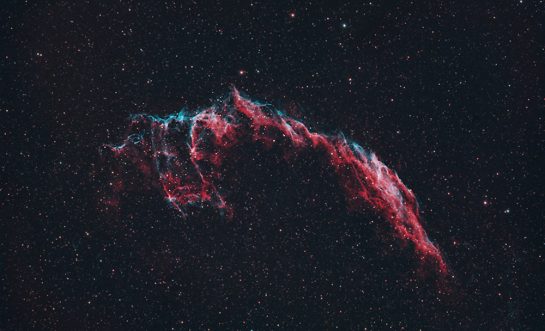
This epitome of the Veil Nebula was captured on an affordable equatorial mount using autoguiding.
Autoguiding is accomplished by sending small corrections to your telescope mount via an ST-iv cablevision communicating from your guide photographic camera to the mount. You can also autoguide using the pulse-guiding method that utilizes a straight connexion from your PC to the telescope mount.
It is said that pulse guiding (with an ASCOM compliant) equatorial mount results in improved guiding accuracy. This can exist measured using the tools institute in the PHD2 guiding software, mainly in the total RMS error reading.
Over the years, I accept fabricated information technology very articulate on my YouTube channel that I don't obsess about these values much. However, if you are looking for a general benchmark, Jerry Lodriguss shared a helpful reference in this Cloudy Nights thread:
- Proficient seeing (two″) averages around 0.3 arcseconds RMS in the guiding
- Average seeing (two-3″) averages around 0.5 arcseconds RMS in the guiding.
- Bad seeing (more than three″) averages around one.0 arcseconds RMS in the guiding.

My portable deep-sky astrophotography setup with a 50mm William Optics 50mm guide telescopic riding on top.
Why it's Useful for Astrophotography
Mod equatorial telescope mounts are quite capable of compensating for the rotation of the Earth, that is what they were designed for. Even so, deep-sky astrophotography (especially at longer focal lengths) is a very enervating application for any entry-level to an intermediate equatorial mountain.
Depending on which telescope mount you're using, subtle errors in the accurateness of your polar alignment tin brainstorm to surface in images as short as threescore-seconds. The slightest fleck of off-remainder in your imaging payload tin put stress on the gears in your mount, which often leads to less than perfect stars in your long exposure prototype.
The QHY PoleMaster device is bully for those looking to hands improve their polar alignment accuracy. Exist sure to check out my total review of this electronic polar scope.
Even with your polar alignment spot-on, and your payload perfectly counterbalanced, autoguiding is oft necessary to runway your object smoothly enough for astrophotography. This is especially true on beginner-level GoTo mounts such as the Sky-Watcher HEQ5 Pro pictured beneath.

My Sky-Watcher HEQ5 Pro mount with a refractor guide scope mounted to the primary imaging telescope
The mount itself may have shortcomings due to worn-out gears or depression-cost materials used in its construction. There is a myriad of potential culprits for periodic mistake in your mount's tracking power. Have a expect at the list of upgrades applied to a "hypertuned" Celestron CG-5 mount. It's a great general list of reasons why your mount may not exist tracking accurately.
- Complete inspection of the mountain head.
- Complete dismantling of the mount head.
- Inspection and cleaning of each office – removing all metal burrs, shavings, thick grease and strange objects.
- High-resolution sanding and polishing of moving internal parts resulting in high smoothness of internal metal parts and "glide similar" functioning from your mount.
- Inspection and adjustment of motors and encoders with gear gear up screws replaced as necessary.
- Replacement of stock worm bearings with ceramic hybrid bearings.
- Replacement of plastic bearings with PTFE bearings.
- Reassembly using loftier-grade synthetic grease.
- Resetting of worm gear meshing.
- Aligning of backlash settings in RA and Dec.
If the problems are severe enough, even autoguiding won't help. For this reason, its always best to invest in a quality telescope mountain that has been proven to exist a reliable choice for deep sky astrophotography.

Thankfully, bones autoguiding is enough to right most of the issues associated with modernistic equatorial mounts. The apply of autoguiding fabricated a dramatic difference to the types of images I was able to capture on my old Celestron CG-five, (Now the Celestron Advanced VX).
What I'thousand Using
I am currently using various autoguiding systems on my Sky-Watcher HEQ5, and Sky-Watcher EQ6-R Pro.
I have used a number of different autoguiding telescopes from the Orion 50mm Mini Guide Telescopic to a William Eyes 72 APO Doublet. If you lot're using a guide scope for autoguiding, a adept rule of thumb is to employ one with a focal length of at least a third of your master imaging scope.
An off-axis guider solves this problem past utilizing the native focal length of your imaging telescope but can add together weight and complexity to your camera organization. Both systems have their strengths and weaknesses, but I personally prefer the simplicity of an auxiliary guide scope over an OAG.
In the post-obit video, you'll encounter me apply autoguiding to collect 3-minute long exposures on the Cocoon Nebula, using a DSLR camera and a 73mm telescope. When using a DSLR camera for deep sky astrophotography, autoguiding not simply allows you to shoot longer just dithering (which helps reduce noise in your stacked epitome) is now possible.
Here is a consummate list of guide scopes I accept used in the past:
- Orion 50mm Mini Guide Scope
- Starwave 50mm Guide Scope
- Starfield 50mm Guide Scope
- Starwave 60mm Guide Scope
- Starfield 60mm Guide Scope
- William Optics Z72 APO Doublet
These days, I primarily use aWilliam Eyes 50mm Guide Scope because information technology is just so lightweight and easy to mountain to various telescopes.
This little telescope features the William Optics Rotolock system, a design feature that securely holds your i.25″ butt guide camera. I accept constitute it very user-friendly to adjust the Rotolock system to move the guide camera in-and-out of the optical tube to observe focus.
The guide telescopic has a focal length of 200mm @ F/iv. You'll need to fit the tube into an appropriate fix of tube rings, or your existing finderscope rings on your telescope.
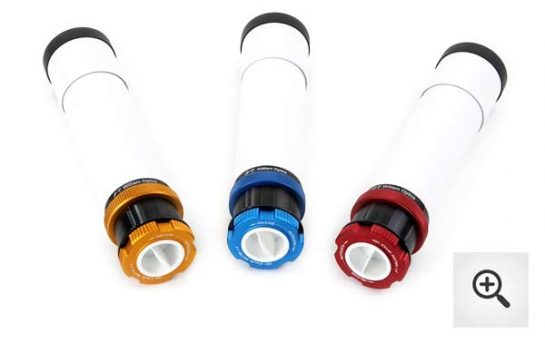
The photographic camera I use nearly often with the 50mm guide scope is the ZWO ASI 290mm mini. This is not but a highly sensitive monochrome guide camera, but information technology'south as well compatible with the ZWO ASIair wifi camera control device and software.
The ASIAIR Plus has its own autoguiding program in the application that communicates with the telescope mount just like PHD2 does.
What you need to start Autoguiding
The basic equipment needed to reach a successful night of astrophotography with autoguiding is a secondary telescope (guide scope) and a guide photographic camera. The guide telescopic rides atop your principal imaging telescope and is usually much smaller. The autoguiding camera is traditionally lighter than your principal imaging camera, and will often include a pocket-size mono CCD or CMOS sensor.
In one case properly connected to your calculator using the advisable cablevision (in my example, a USB 2.0 A-male to B-male cable), the autoguiding camera will broadcast a live-loop image through the guide telescopic to your computer.
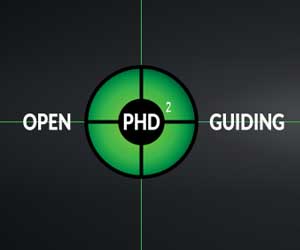
How it works
The principal objective of your autoguiding organization is to focus and lock onto a star in the guide telescope'southward field of view. The camera will continuously capture brusk exposures through the guide telescopic, usually anywhere between one and 3-seconds in length.
The guide photographic camera and your telescope mount communicate with each other to maintain a lock on your target by making subtle corrections to the tracking. This is accomplished by using a nifty piece of free software adult by Stark Labs.
PHD2 Guiding
By using autoguiding software such every bit PHD2 Guiding, our computer can communicate with the telescope mount. PHD2 Guiding is the successor to PHD Guiding, which I used for several years before upgrading to PHD2. PHD stands for "Push Hither Dummy", and information technology very easy to use, in one case everything is set up properly.
This software can also do other useful astrophotography tasks such as drift alignment, which is helpful for those who cannot use Polaris for Polar Alignment.
In early 2017, I upgraded my autoguiding system to include a more than sensitive camera, and an improved guide scope:
PHD2 Guiding includes a user interface that allows you to enter in your specific connexion type and autoguiding photographic camera model. Currently, I use an Altair GPCAM2 (AR01030 Mono) guide camera with a Starfield 50mm guide telescopic. This combination works extremely well, and I spend very petty fourth dimension dealing with anything related to autoguiding these days.
When autoguiding with the iOptron CEM60 mountain, I can utilize the dithering and autoguiding features directly from my laptop reckoner to the mountain. This means that I no longer need to connect the ST4 cable to the guide port from the camera, as the ASCOM interface communicates with the mountain directly.
My Process
- Attach 60mm Guide Scope to finder shoe of the chief imaging telescope
- Install Altair GPCAM2 photographic camera to the guide scope
- Connect camera to reckoner via USB 2.0 A-male person to B-male cable
- First PHD2 Guiding and Connect to Camera and Mount
- Slew to your deep-sky target, eye, and frame using APT
- Articulate mount calibration and starting time a new live loop (1-second exposures)
- Select Tools > "Automobile Select Star"
- Run PHD2 calibration routine on the star chosen by PHD2
- Make certain Dither part on APT is selected under the "Guide" tab
I use a 1-second refresh rate on the Altair GPCAM2 to display an assortment of stars inside the field of view. It is of import to make certain that the guide scope is properly focused to ensure accurate star tracking. When PHD2 is running, I ordinarily open on the "graph" window to monitor the accurateness of the tracking.

Please consider visiting the Larn Astrophotography section of this site to explore my techniques during real-life situations in the lawn.
What is Off-Axis Guiding?
Off-axis guiding (or OAG), involves using a device that sends starlight to your guide photographic camera from the optical axis of your primary imaging telescope. It does not bear on your primary imaging photographic camera, as it uses the starlight that is "off-centrality" and not inbound your primary imaging camera.
I accept used the Lumicon Like shooting fish in a barrel Guider for off-centrality autoguiding with my iOptron SkyGuider Pro. The option-off prism sent useful guide stars to my ZWO ASI290mm mini guide photographic camera to make corrections to the telescope mount for long-exposure astrophotography.
![]()
Using an OAG for autoguiding on an iOptron SkyGuider Pro.
No matter which method of autoguiding you use, the goal is simple. To capture long exposure images with round, abrupt stars. If you're able to collect images of over 3-minutes in length through your telescope, your autoguiding system has done its job.
Final Thoughts
Autoguiding is something that you lot won't fifty-fifty recall about, in one case you lot've got information technology working properly. For those having problems with autoguiding early on on, I urge yous to ensure that your telescope mount is properly polar aligned and balanced (with no cable snags) before trying to diagnose autoguiding issues.
Also, don't captivate about the numbers and guiding graphs within PHD2 guiding. If y'all are chasing numbers, chances are you're not taking pictures. If you lot're taking pin-sharp v-minute exposures at a focal length of 1000mm or more, chances are your autoguiding organization is working just fine.
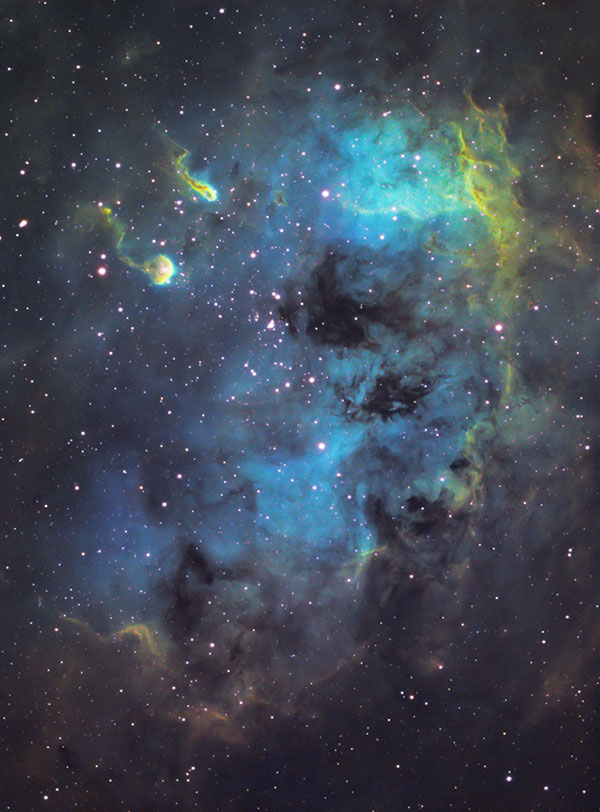
Source: https://astrobackyard.com/autoguiding/
Posted by: humbertthosee.blogspot.com

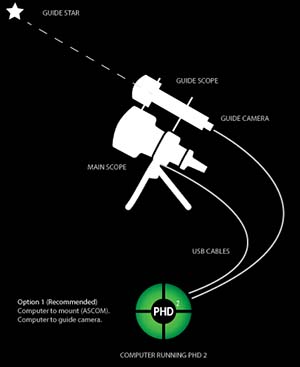
0 Response to "Is There An Autoguider For Eos Canon Cameras"
Post a Comment